|
|
 |
|
|
654. Schwere Panzerjäger Abteilung
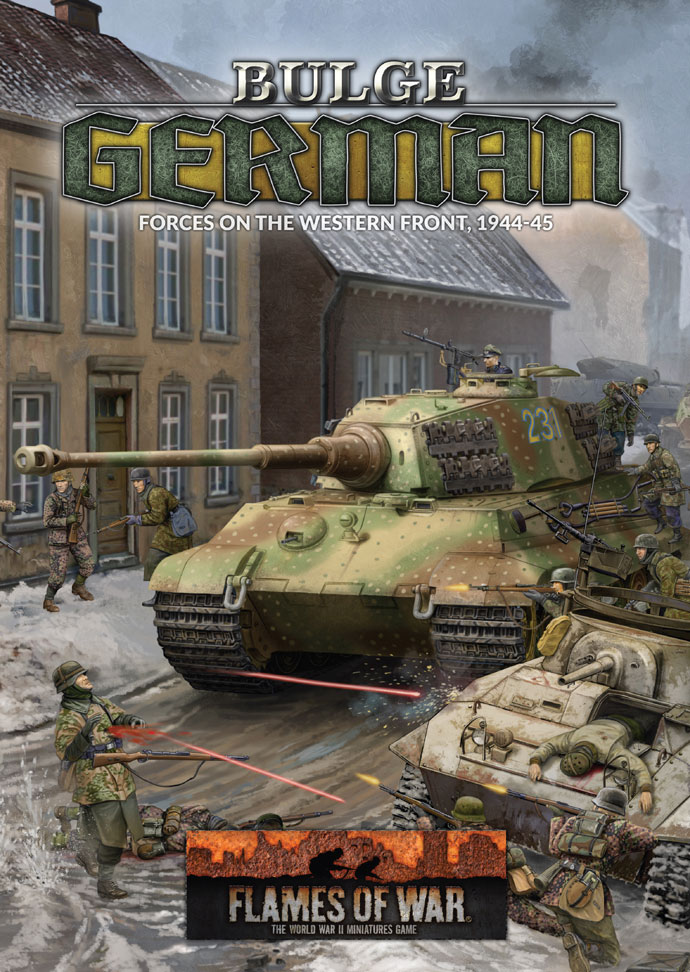 |
654. Schwere Panzerjäger Abteilung
(654th Heavy Tank-hunter Battalion) Normandy, July 1944
“The British ‘infantry’ tanks had a horrible time. The Argylls of 15th Scottish, less their anti-tank guns, but supported by the Churchill tanks of Scots Guards, took and held a height known as Quarry Hill (Mont Pincon, Southwest of Caen), when there were three shots and three Churchill tanks ‘brewed’. Then two enormous Jagdpanther tank-hunters, covered by a third, lumbered into the open, up the hill, through the British position, and down the other side, leaving in all eleven shattered Churchill tanks behind them. One of the Jagdpanther tank-hunters passed within a few feet of an artillery officer who had a close view of the German commander who was standing up, wearing only a vest, presumably because of the heat, and laughing. These enormous vehicles mounted a 88mm gun some 23 feet long on a Panther chassis.”
—From the history of the 3rd Armoured Battalion (Scots Guards), 6th Guards Tank Brigade.
The Hunting Panther
The success of the 8.8cm gun had a direct influence on the design of German tanks and tank-hunters.
|
|
The 8.8cm PaK43 was too big to be useful on a Panzer III or IV chassis, so German industry sought a compromise to upgrade the slow manoeuvring heavies such as the Ferdinand assault gun and Königstiger heavy tank.
The Army Weapons Office’s answer was the Jagdpanther (Hunting Panther, pronounced yahkt pan-terr). This placed an 8.8cm PaK43 on a Panther tank to combine the firepower of the big gun with the higher mobility of the Panther.
|
|
Initial designs called for the Jagdpanther to be based on the Panther II, but once the Panther II was scrapped in favour of upgrading the standard Panther, the Jagdpanther changed to that chassis instead.
The main result was the lowering of the front armour to 80mm armour instead of the intended 100mm of the Panther II. The first Jagdpanther tank-hunters sported Zimmerit protective coating, but those produced after 8 September 1944 did not.
Initial Deployment
The first unit to receive the Jagdpanther was 654. Schwere Panzerjäger Abteilung (654th Heavy Tank-hunter Battalion).
|
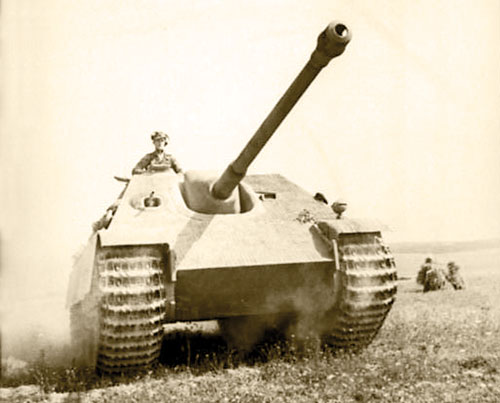 |
| This unit fought with towed anti-tank guns through Poland, Holland, and France. Then in 1943 it was re-equipped with Ferdinand heavy tank-hunters for the Kursk battles. |
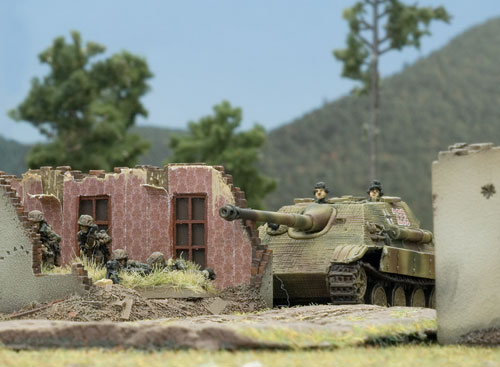 |
After Kursk the battalion was reformed at the Mielau training facility in France. In February 1944, the unit received eight Bergepanther recovery vehicles for driver training. However, it wasn’t until 23 March that the first two Jagdpanther tank-hunters arrived at the school.
April saw eight Jagdpanther released to the 654th. Orders had each Jagdpanther Kompanie scheduled to receive 14 Jagdpanther’s, with the battalion command receiving three modified command vehicles.
Production shortfalls prevented any further deliveries before the D‑Day invasion.
|
| Although it was reported to Hitler on June 11 that the Abteilung was combat ready, it still had not received any more vehicles. The original eight vehicles were assigned to the 2. Kompanie, and loaded on railcars for transfer to Normandy on 15 June. They reached the front by 29 June. |
|
A 1 July report has the Abteilung claiming 25 Jagdpanther’s, but the additional 17 vehicles had only just arrived at the training camp. The rest of 2. Kompanie and 3. Kompanie now began training in earnest. At the same time personnel for 1. Kompanie also arrived at the camp for training, but they would not see their Jagdpanther’s for over a month. One more Jagdpanther and three Panther command tanks were all that were delivered to the battalion in July.
First Blood
The battalion staff, the rest of 2. Kompanie, and 3. Kompanie arrived at the front on 17 July. |
|
Placed in reserve with XLVII Panzerkorps (47th Armoured Corps), they did not see action until 30 July when they were sent to support 326. Infanterie Division (326th Infantry Division) attempting to stop the British Operation Bluecoat.
Elements of the 3rd Tank Battalion (Scots Guards), 6th Guards Tank Brigade were the first to meet this new German behemoth near St. Martin des Bois. Within the first two minutes of battle, three Jagdpanther’s destroyed eleven Churchill tanks on Quarry Hill.
|
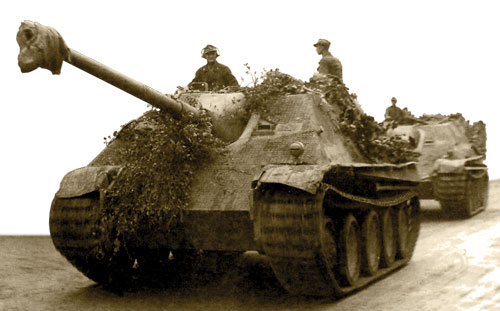 |
 |
|
Another column of Churchill tanks managed to flank three other Jagdpanther’s and the battalion staff. The Churchill tanks managed to disable two of the Jagdpanther’s and one of the battalion Panther command tanks. These three were abandoned when the Germans were forced to retreat.
Mechanical Problems
On 1 August the battalion was back to its original eight tank-hunters ready for action. The final drives of the Panther engine design only lasted about 35 kilometres in a Jagdpanther before the drive shafts gave out. It took the German designers until October before a solution to the final drive problem was developed.
Later in August 1. Kompanie finally received their full complement of Jagdpanther tank-hunters. 654. Schwere Panzerjäger Abteilung was finally whole. This would be the only time a heavy tank-hunter battalion was fully outfitted with Jagdpanther’s, as on 11 September Hitler ordered that all heavy tank-hunter battalions would now be outfitted with one company of Jagdpanther and two companies of Jagdpanzer IV tank-hunters.
Battle of the Bulge
After escaping from the Falaise Pocket in Normandy, 654. Schwere Panzerjäger Abteilung, now in Germany, continued to receive priority replacements to prepare for the winter offensive. They reached a total of 45 Jagdpanther tank-hunters on 15 November, along with four quadruple 2cm FlaK38 and four 3.7cm FlaK43 guns on Panzer IV chassis for air defence.
Subordinated to LXIII Armee Korps (68th Corps), the battalion fought non-stop through the rest of November, claiming 52 enemy tanks destroyed while losing 18 tank-hunters and two 2cm anti-aircraft tanks.
Reduced to a total of 27 Jagdpanther’s, the battalion entered the Ardennes winter offensive reporting just 24 operational. After receiving another 20 Jagdpanther’s, they reported 28 operational on 30 December with another 7 in repair. Two weeks later there were just 26 ready for the final defence of the Fatherland.
|
30 July - 1 August, Situation map
Operation Bluecoat |
|
When it arrived in Normandy, 654. Schwere Panzerjäger Abteilung was placed in reserve under XLVII Panzerkorps. Its first combat mission was to support 326. Infanterie Division against the British Operation Bluecoat.
The three German Panzer divisions on this part of the front had been diverted to face US armoured divisions threatening to breakthrough the German lines in the west. This left the three Grenadier regiments of 326. Infanterie Division responsible for covering a huge area of the front line between the US front in the west and II SS-Panzerkorps (2nd SS Armoured Corps) in the east.
The unexpected advance of the British VIII and XXX Corps towards Vire required 654. Schwere Panzerjäger Abteilung to block a hole torn by the 15th (Scottish) Division and 6th Guards Tank Brigade. The Jagdpanther tank-hunters destroyed most of a tank company in their counterattack, allowing 326. Infanterie Division to restore its lines.
|
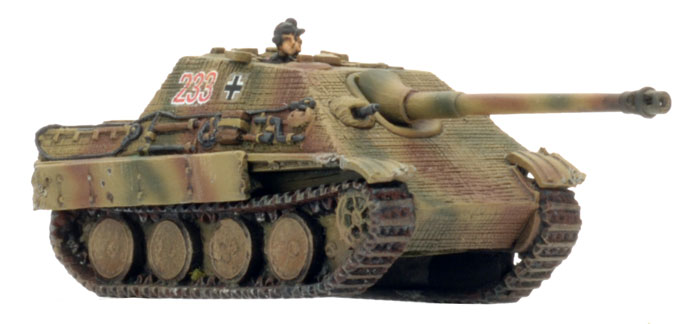 |
In Flames Of War
You can field a Jagdpather Tank-hunter Company using Bulge: German.
|
Last Updated On Tuesday, May 24, 2022 by Wayne at Battlefront
|
|
|